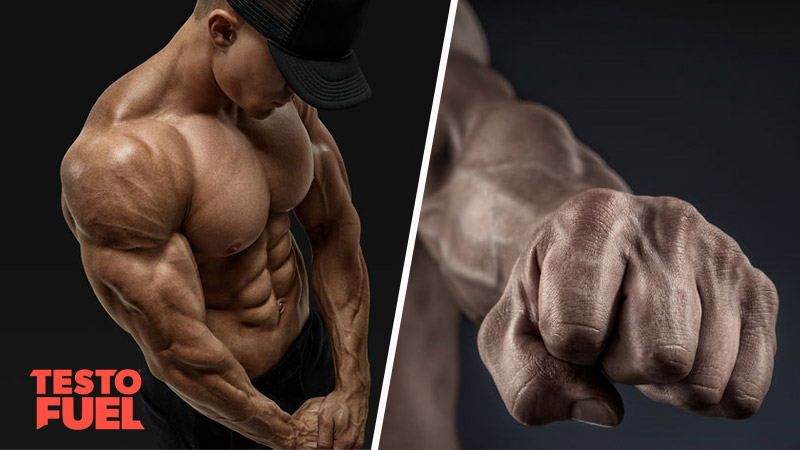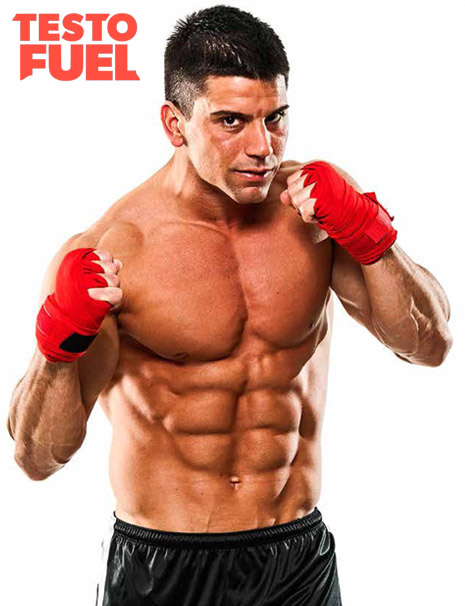TestoFuel Blog : Make Gains & Pack on the Muscle

You want a broader chest, stronger arms and legs that show off your dedication. You want to add slabs of muscle. The problem is though that you’re unsure of the best way to get it.
It has always been thought that in order to bulk up you had to lift big.
Just look at Pumping Iron – the seminal bodybuilding film from the late 1970s. Not only were they all huge, but they all trained the same way – big, heavy lifts. ‘Go heavy or go home’ was the motto.
But as modern science evolves could there be more to it than simply upping the load? Can you add muscle with light weights?
In this article we take a look.
A good place to start would be to look at exactly what happens when muscles grow.
The science can be quite complicated but it’s worth learning about, as your new knowledge will directly help you in the weights room.
There are two types of hypertrophy – the scientific name for building muscle. These are myofibrillar and sarcoplasmic hypertrophy.
So when we talk about adding muscles we’re talking about two different mechanisms. And each one of these is thought to be triggered by different different loads and different rep ranges.

For many years the theory has been that as myofibrillar hypertrophy increases so does strength. And that makes sense. As the muscle fibers get bigger they can generate more force.
For that reason it is often referred to as functional muscle building. It has an effect that improves the way your body works.
So to improve myofibrillar hypertrophy you need to lift heavy weights for low reps, have long rest periods and low total sets.
Sarcoplasmic hypertrophy on the other hand contributes to overall muscle build but doesn’t directly influence the contractile unit of the muscle to the degree that functional muscle building does. It therefore doesn’t improve strength – but it does help you achieve fuller, more muscular physique though.
Moderate weights for moderate to high rep ranges coupled with lower rest times help to achieve this. You’ll also get a great pump due to the increase in blood flow to the muscle..
This is where it get interesting. Because research shows that light weights are as much as a stimulus for muscle growth as heavier weights are.
An early study by Morton et al [1] found that both hypertrophy and strength improved in a similar way regardless of how heavy the weights were.
In the study, the research team recruited 49 men who were experienced at lifting weights. Each of the volunteers were asked to complete 12 weeks of full-body resistance training that involved either
A key feature of both groups was that every set was take into fatigue regardless of how heavy the weights were.
After the 12 weeks were over, 1RM improved in both groups to the same degree, with the only difference being the bench press score was higher in group 1. There were no differences at all in muscle fiber size and no changes in testosterone or any other hormones.
More recently, Brad Schoenfeld and his colleagues published a similar investigation to the one above, this time in the Journal of Strength and Conditioning Research [2].
The 2015 study selected 18 young men, all with experience of lifting weights, and assigned them to one of two groups – pretty much the same method as in Morton’s study.
This time though, both groups performed specifically 3 sets of 7 different exercises covering all major muscle groups. They did this 3 times per week for a total of 8 weeks.
Again, both groups improved muscle build with no differences between the higher or lower rep groups.
They heavier weight group did however see significant improvements in their back squat 1RM as well as a slightly less but still significant increase in bench press 1RM.
In 2016 the leading researchers in the area of muscle hypertrophy decided to conduct a meta-analysis on the matter of rep ranges and hypertrophy. This means that they pulled together every research paper on the topic, and then conducted statistical analysis as one large study.
Again conducted by Schoenfeld and colleagues [3], the analysis included 9 different studies looking at strength and 8 that looked at hypertrophy.
What they found mirrored previous independent research. Strength improved slightly more in higher load groups in comparison to lighter loads.
Hypertrophy however was pretty much the same, with only a trend for increased muscle build in the heavier approach to training.
What you have to appreciate is that every person is different. Most of these studies showed no difference between loads as high as 90% and as low as 50% – that’s a massive variation. That means that all-in-all you can go as heavy or as light as you want and still get similar results.
One study from the journal of Applied Physiology, Nutrition and Metabolism [4] reported that weights as low as 30% of your rep max can stimulate decent amounts of hypertrophy. The key factor in that happening though?
Reaching fatigue.
So far all of the studies we’ve talked about have one thing in similar – the volunteers lifted weights until they reached fatigue.
Fatigue has been found to stimulate higher muscle fiber activation. It also recruits more high threshold motor units – a part of the nervous system responsible for coordinating and switching on your bigger, larger muscle fibers [5].
It is worth noting though that fatigue is different to muscular failure.
So what’s the difference?
Fatigue means you can’t complete any more reps because the burning feeling in your muscles becomes too much. There’s a build up of byproducts such as hydrogen and lactate and it’s becoming unbearable and you’re struggling to do any more. But if someone gave you $50 to knock out another 2 or 3 reps you’d be able to grind them out.
Failure on the other hand is different. It isn’t to do with byproducts. It’s more to do with the nervous system not being able to send signals to your muscle fibers to contract. And no matter how much you try, you just can’t complete another rep.
But why go to fatigue and not failure?
Failure takes longer to recover from, increases the chances of injury, and simply isn’t necessary. You can still stop your set 1 or 2 reps before failure and still get excellent muscle growth.
We’ve always been told that in order to add slabs of muscle you need to lift heavy.
But more and more research is showing that the weights you choose aren’t that important, with lower rep ranges showing minimal differences when compared to higher alternatives.
So if your primary goal is to get bigger, current research suggests that it doesn’t really matter what rep range you use. What does matter though is that you reach fatigue.
If you want to get bigger and stronger though then stick to heavier weights.
